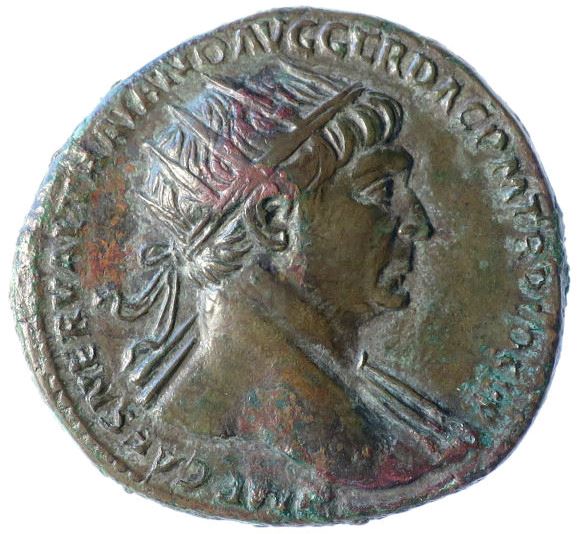The dupondius (Latin two-pounder) was a brass coin used during the Roman Empire and Roman Republic valued at 2 aes (1/2 of a sestertius or 1/8 of a denarius).
The dupondius was introduced during the Roman Republic as a large bronze cast coin, although even at introduction it weighed less than 2 pounds. The initial coins featured the bust of Roma on the obverse and a six-spoked wheel on the reverse.
With the coinage reform of Augustus in about 23 BC, the sestertius and dupondius were produced in a golden colored copper-alloy called orichalcum (brass).
The dupondius was normally further distinguished from the similarly sized as with the addition of a radiate crown to the bust of the emperor in 66 AD during the reign of Nero.
The dupondius was introduced during the Roman Republic as a large bronze cast coin, although even at introduction it weighed less than 2 pounds. The initial coins featured the bust of Roma on the obverse and a six-spoked wheel on the reverse.
With the coinage reform of Augustus in about 23 BC, the sestertius and dupondius were produced in a golden colored copper-alloy called orichalcum (brass).
The dupondius was normally further distinguished from the similarly sized as with the addition of a radiate crown to the bust of the emperor in 66 AD during the reign of Nero.

(1)
Marcus Antonius

Obverse: M ANT IMP TERT COS DESIG ITER ET III VIR RPC - Bare head of Mark Antony right, facing draped bust of Octavia left.
Reverse: M OPPIVS CAPITO PRO PR PRAEF CLASS F C - Two quinqueremes sailing right; caps of Dioscuri above, B below.
Diameter:
21 mm
Die Orientation: 0 H
Weight: 7.76 g
Die Orientation: 0 H
Weight: 7.76 g
Provenance: Privately purchased from NAC (March 2021), Ex Numismatica Ars Classica, Auction 59 (4 April 2011), lot 860.
RPC I 1469
